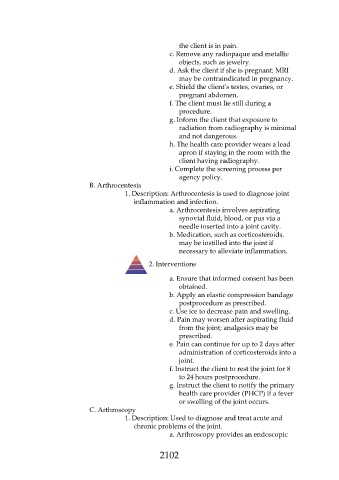Page 2102 - Saunders Comprehensive Review For NCLEX-RN
P. 2102
the client is in pain.
c. Remove any radiopaque and metallic
objects, such as jewelry.
d. Ask the client if she is pregnant; MRI
may be contraindicated in pregnancy.
e. Shield the client’s testes, ovaries, or
pregnant abdomen.
f. The client must lie still during a
procedure.
g. Inform the client that exposure to
radiation from radiography is minimal
and not dangerous.
h. The health care provider wears a lead
apron if staying in the room with the
client having radiography.
i. Complete the screening process per
agency policy.
B. Arthrocentesis
1. Description: Arthrocentesis is used to diagnose joint
inflammation and infection.
a. Arthrocentesis involves aspirating
synovial fluid, blood, or pus via a
needle inserted into a joint cavity.
b. Medication, such as corticosteroids,
may be instilled into the joint if
necessary to alleviate inflammation.
2. Interventions
a. Ensure that informed consent has been
obtained.
b. Apply an elastic compression bandage
postprocedure as prescribed.
c. Use ice to decrease pain and swelling.
d. Pain may worsen after aspirating fluid
from the joint; analgesics may be
prescribed.
e. Pain can continue for up to 2 days after
administration of corticosteroids into a
joint.
f. Instruct the client to rest the joint for 8
to 24 hours postprocedure.
g. Instruct the client to notify the primary
health care provider (PHCP) if a fever
or swelling of the joint occurs.
C. Arthroscopy
1. Description: Used to diagnose and treat acute and
chronic problems of the joint.
a. Arthroscopy provides an endoscopic
2102

